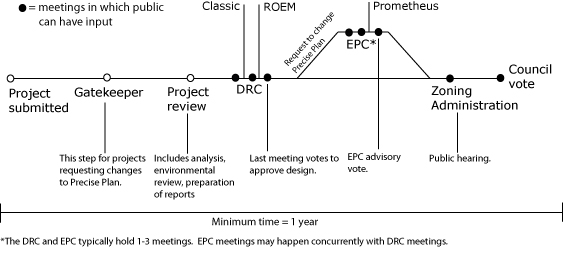by Deb Keller
Ever get one of those colored postcards from the City saying that there’s some kind of meeting open for public comment? Typically I read them, note that the meeting is at an inconvenient time for me, and throw them in the trash.
How do I know what to go to? Is it even worth my time?
To answer the first question I met with Randy Tsuda, Community Development Director. Randy walked me through the steps of the development cycle.
The Players
First, let me introduce you to the players.
Development Review Committee (DRC) The DRC is made up of a project manager from the City and architects, who are paid consultants. The DRC generally holds 1-3 meetings for a project, and these look at features of the site and the plans. I went to one of these and found it pretty dull. They go over a lot of minutia. But if there’s a development going up next to you, it’s definitely worth going to, because these meetings determine how it’s going to look.
Environmental Planning Commission (EPC) The EPC is made up of seven unpaid volunteers who are appointed by City Council for 4-year terms. Since the EPC deals with the more contentious issues, these meetings can be more lively.
The EPC’s vote is advisory only; Council does not necessarily need to follow their guidance. However, I think it’s fair to say that this is one of the key inputs for Council.
City Council The Deciders. Council ultimately gives the thumbs up or thumbs down on a development project. Connecting with the seven Council members is naturally one of the more important things you can do.
Zoning Administrator (ZA) The ZA makes recommendations for large development projects, and holds a public hearing.
The Process
To make this simpler, I’ll just consider three substantial projects that will impact Old Mountain View — by developers Classic Communities, Prometheus, and ROEM–and look at where they are in the process today. The process is illustrated below.

The process for larger developments takes about a year at the minimum. Note that the EPC and DRC meetings may go on concurrently.
Two steps differ for the Prometheus project. The developer is asking for the Precise Plan to be changed. When a change is requested, there’s a Gatekeeper step where the city decides whether the plan has merit and if City staff should be allocated or not. The second step that’s added is that the EPC steps in.
A question I’ve heard in the case of the Prometheus development at 455 W. Evelyn is that it seems like the horse is before the cart. The project has been through four DRC meetings, futzing around about the porches, but the contentious issue of density won’t be addressed until the EPC and Council votes at the end of what’s typically a one-year process. Shouldn’t the density issue be handled first?
In fact a developer can do that, but it’s their decision. “Developers can turn in any project they want,” noted Randy, “and it’s really up to them as to whether they go through the process to change the Precise Plan first.”
Is it Worth Getting Involved?
I’ve heard opinions about local development ranging from cynicism to confidence that our City government is watching out for us.
The City does encourage neighborhood input. At the EPC, DRC, and Council meetings, public comment is allowed in a 3-minute statement. While attending a meeting can be time-consuming, it is easy to send an email.
I never paid much attention to development, believing “somebody” was paid to take care of all that. And then one day a new development appeared at the end of my street. One that I didn’t much like.
I’m sure I got a colored postcard from the City about the development, giving me ample opportunity to learn about the project and voice my opinion. The point is this: Once a development is built, it’s there to stay. The time to speak up is somewhere along the development process timeline..
Author’s note: Many thanks to Randy Tsuda who was patient in helping me understand this process. All opinions, errors and omissions are mine. Please correct me on anything by adding a comment below.

